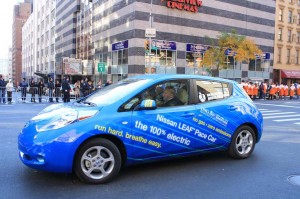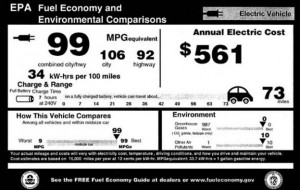
The Nissan Leaf recently paced the NY Marathon. Now, says the EPA, it is setting the pace for the rest of the midsize auto segment.
The Nissan Leaf gets 99 miles to the gallon and can go for at least 102 miles per charge, according to new government fuel economy ratings. Or is that 100 miles before having to plug in again? Or 120?
While the EPA’s long-awaited calculation, which will appear on the window sticker of the Japanese battery-electric vehicle, or BEV, should please many green-minded motorists, it’s likely to confuse plenty of others.
The government’s challenge has been to come up with ways to measure the efficiency of a battery car in a manner comparable to the current fuel economy calculations used for conventional gas-powered automobiles. But skeptics question whether the new numbers are any better than a controversial earlier proposal that would have shown Leaf’s fuel economy at something close to 400 mpg.
As it stands, the pure battery-powered Nissan Leaf is the most fuel-efficient car in the midsize segment, according to the Environmental Protection Agency, which is charged by law with determining the mileage of new cars, trucks and crossover. The agency’s finalized testing process gives Leaf a Combined 99 MPGe figure, or miles per gallon equivalent, which is a measure of what an alternative fuel vehicle actually would get if it were powered by gasoline.
In city driving, Leaf will be rated at 106 MPGe, while the highway rating will be 92.
To determine that number the EPA calculates that 33.7 kilowatt-hours of energy is the equivalent of a gallon of gas. So that means it took just slightly more than amount of energy, either stored in Leaf’s batteries or lost due to inefficiencies in the charging process to propel Leaf 99 miles.
Nissan claims the Leaf will typically get 100 miles per charge using 24 kilowatt-hours of lithium-ion batteries. But the so-called Munroney window stick will display a range of 73 miles, reflecting what’s known as the five-cycle test EPA developed to reflect what motorists might experience driving during a variety of real-world driving conditions.
Stuck in New York traffic, creeping along at 20mph on a blustery winter commute home, with lights on and the heater on full, a battery car like Leaf will see its range diminished sharply, especially when compared to a drive on a warm spring afternoon, with only occasional stops and neither the lights or heat in use. In fact, the EPA’s so-called LA4 cycle rates Leaf at 120 miles range.
Confused yet? Consider that the EPA is categorizing Leaf in the midsize segment even though the vehicle has a compact car footprint but a slightly larger interior reflecting the flexibility designers have once they eliminate the big engine normally found in the front of a conventional automobile.
“We’re pleased the label clearly demonstrates the Nissan LEAF to be a best-in-class option, reflecting that it’s a pure electric vehicle, uses no gas, has no tailpipe and has zero emissions,” said Scott Becker, senior vice president, Finance and Administration, Nissan Americas, describing the new ratings system as a helpful “tool to compare” different vehicles using different forms of propulsion.
Apparently not everyone is so pleased. While its new Chevrolet Volt plug-in hybrid is now going on sale, the General Motors division has yet to get a go-ahead for Volt’s window sticker data. Insiders say that’s because GM strongly disagrees with the EPA results. At one point, the government proposed a rating of 270 MPGe for Volt, a figure it is now expected to sharply downsize.
Volt underscores just how difficult it will be to come up with not just valid or useful fuel economy numbers.
The Chevy hybrid is designed to run anywhere from 25 to 50 miles on a charge of its downsized battery pack, then automatically switch on its gasoline engine for longer drives. For short drives on battery power, Volt would be roughly as efficient as the Nissan Leaf. But once the gasoline engine kicks in, efficiency falls sharply.
A test drive of Volt by TheDetroitBureau.com, last month, found that I4 portion of the powertrain yielding about 40 miles per gallon. So, assuming about 40 miles on battery power, a 60-mile drive would only consume a half gallon which could conceivably be calculated to equal 120 MPG. A 240-mile drive, however, would consume about 5 gallons on top of a full charge of the batteries, or 48 MPG.
A GM spokesman says the automaker is “making progress” in its discussions with the EPA. But until there’s a Munroney sticker for the window, Chevy won’t be able, under law, to sell a single Volt.

